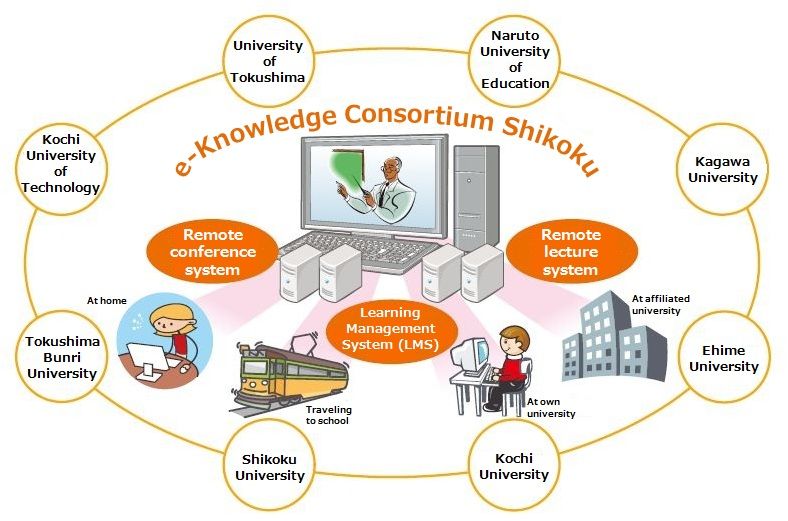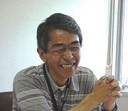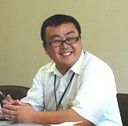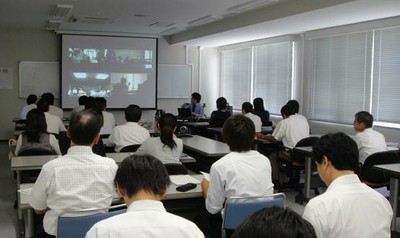
Developing the Human Resources to Build a Better Shikoku Based on the Collective Results of the ”Knowledge of Shikoku” Project
Kagawa University has set up the e-Knowledge Consortium Shikoku with seven other universities in Shikoku. The aim is to develop human resources capable of boosting the Shikoku region, based on the collective results of the ”Knowledge of Shikoku” project, a strategic alliance of universities in the region. We discussed the objectives and current status of the project with Professor Zengo Furukawa of the Department of Reliability-based Information Systems Engineering in the Faculty of Engineering, Kagawa University, who also serves as director of the university’s Information Technology Center, and with Associate Professor Toshihiro Hayashi of the same Center.
(Interview date: July 7, 2009)
Please tell us first about the activities of the Kagawa University Information Technology Center.
Furukawa: The mission of our Center includes provision of the Kagawa University information infrastructure, the environment for information sciences education, and the school-wide database. We are responsible for planning and strategy aspects, such as promoting the university’s use of information technology, as well as building and administering the systems and networks of the whole university. As information and communication technologies continue to advance, the role of the Information Technology Center is also changing significantly. In the past, the emphasis was on basic computer literacy education and other basic functions; but lately we need to be active in a wide range of fields, offering information technology support for students’ job-seeking activities, as well as specialized education in various faculties of the university. We are taking these needs into account as we design the university’s information infrastructure. As a member of the engineering faculty, I am engaged also in research on raising software quality and participate in the activities of groups like the NPO ASTER (Association of Software Test Engineering) and JaSST (Japan Symposium on Software Testing).
Hayashi: My graduate school major was in the field of educational technology, and my work in the Center also consists mainly of building and administering systems for educational use. These include e-Learning and remote lecture systems, as well as the PC environment for use in learning. As a lecturer in the Faculty of Engineering, I also give students graduate research guidance on educational engineering topics
You and seven other Shikoku universities have formed the e-Knowledge Consortium Shikoku.
Please give us some background.
Hayashi: The declining birthrate and aging of Japanese society affects us in Shikoku as well, where the population is forecast to decline by 1.2 million people by 2050. For Shikoku to continue developing on its own, we need to share an awareness of ”Shikoku as one,” and must educate the people who will be actively involved in building up the region. They need to be deeply rooted in the community and have highly specialized knowledge and skills. As the institutes of learning responsible for such activities, universities would seem to be the best suited. There are limits, however, to what can be accomplished by the efforts of individual universities acting individually. Each prefecture and region in Shikoku has its own features and each has its own fields of specialty. In thinking about these issues, the idea that arose was to form a consortium, that is, a broad coalition of universities in Shikoku working together toward developing human resources.
What are your specific goals for human resource development?
Hayashi: One is to produce people who can play a leading role in Shikoku’s revitalization, helping to put energy back into the region. These are people who will be able to foster emotional attachment to and local pride in Shikoku, and who can carry out activities toward more widespread understanding of Shikoku’s tourism and cultural assets, in order to boost the region. A second goal is to produce people who can raise the level of the agricultural, forestry, and fishing industries in the region. As you know, these are key industries in Shikoku. We want to train people who can design business models that bring together agriculture, commerce, and industry to raise the brand awareness and quality of the products in these industries.
What is the current status of your efforts?
Hayashi: The current project is aggregating the ”knowledge of Shikoku,” based on Shikoku Studies called Shikoku-gaku encompassing Shikoku’s broad issues and resources, brands, history, geographical features, culture, traditions and so on. Eventually we plan to make wide use of content related to these Shikoku studies, but in the 2009 academic year we are in the phase of content creation and collection in each university. Our university is also hard at work creating content. We will be producing around 10 materials in all, including a course in Sanuki studies on Kagawa themes. Since we feel various kinds of specialized education will be necessary for the actual human resources development, we are also proceeding with such content creation as courses related to information technology literacy. In the next academic year and following we will enter the phase of full-scale content utilization, but would like to start making use of available content as early as the second semester of this year.
From a system standpoint, will you be focusing on remote lectures and e-Learning?
Hayashi: Even though the project is taking place inside Shikoku, actually having students take courses in other universities is no easy matter. In some cases they would have to travel between prefectures. We therefore wanted to make use of remote lectures and e-Learning if possible, enabling students to take outside courses without leaving their own university. For the remote lectures, we plan to install high definition video conference systems (Polycom®, etc.) in each university and use these for providing courses. One problem we will need to study is the different class starting times of each university. Incidentally, since we face a similar travel problem for meetings in the consortium, we are holding remote meetings using Microsoft’s Live Meeting. As for e-Learning, we plan to make available recorded videos from lectures, learning materials in Flash format and so on, putting them on the learning management system of each university for access from other universities.
The network on which these depend is SINET, right?
Furukawa: That’s right. A high-speed information infrastructure linking each university is essential to an inter-university undertaking like this. A major premise of this project was the existence of SINET as a scientific information network. Someone planning to do this sort of thing in the past would have needed to start out by deciding how to set up networks between each university. That would have been a very high hurdle to overcome. This time, not having to worry about the network, we were able to concentrate from the start on the nature of the project itself. That would certainly not have been the case if SINET did not exist.
Do you have any further wishes regarding SINET?
Hayashi: We have no real concerns about the network speed and reliability. When using the network for e-Learning content, however, this often involves having students access the LMS of another university, which leaves us with the issue of how to handle user authentication. Right now we are thinking about using Shibboleth, but we would welcome any support from SINET in this area.
Finally, please tell us about your goals for the future.
Hayashi: Although the 2010 academic year will mark the end of this undertaking as a Strategic University Partnership Support Project, human resource development will require a long-term undertaking. We therefore plan to continue with ”Knowledge of Shikoku” educational programs in the 2011 academic year and beyond. The efforts also will need to be expanded beyond universities to encompass museums, cultural facilities, and local administrations, in tie-ups with a range of organizations in the region. As a native of Kagawa myself, I want to contribute as much as possible to infusing Shikoku with new vigor.
Furukawa: I will be happy if a united base can be created for Shikoku using information technology and networks. In addition to this project, the Information Technoligy Center is taking up many other challenges, such as improving the network environment linking the four Kagawa University campuses. As we proceed with such projects we have great hopes for further SINET development and support.




